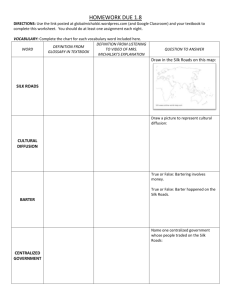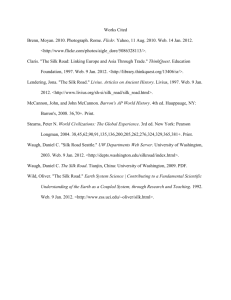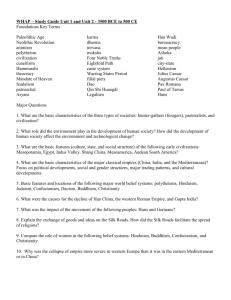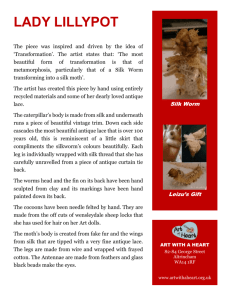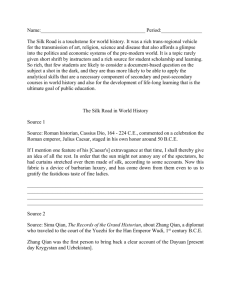INQ 270, Spring 2011 - East
advertisement
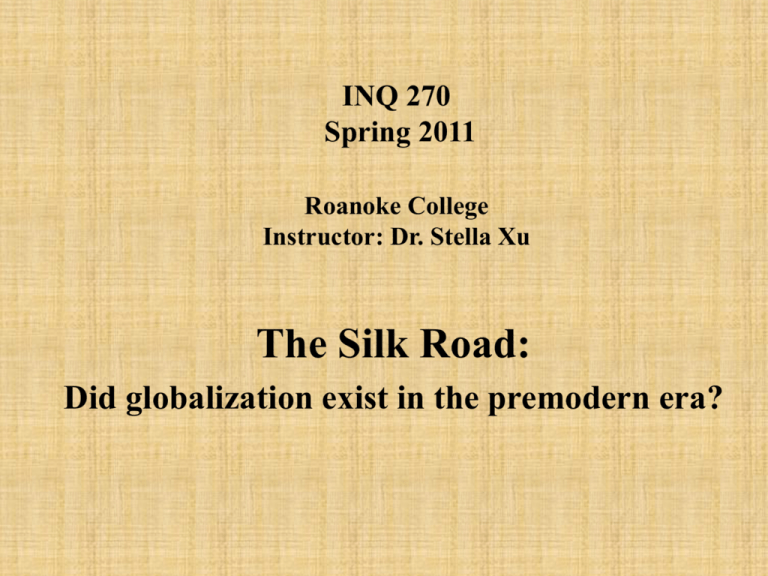
INQ 270 Spring 2011 Roanoke College Instructor: Dr. Stella Xu The Silk Road: Did globalization exist in the premodern era? Required Textbooks • Bentley, Jerry H., Old World Encounters: Cross-Cultural Contacts and Exchanges in Pre-Modern Times . Oxford University Press, 1993. • • Hayashi, Ryoichi, The Silk Road & the Shoso-In. Weatherhill/Heibonsha ser., 6. 1975. • • Wriggins, Sally H., Xuanzang, A Buddhist Pilgrim on the Silk Road, Westview, 1997. • • Wood, Michael, In the Footsteps of Alexander the Great. California, 1997. • • Yu, Anthony trans., Journey to the West. • • Komroff, Manuel ed., The Travels of Marco Polo, New York: Liverright, 2003. • Liu, Xinru, The Silk Road, American Historian Association Essays on Global & Comp. History Series. • Whitfield, Susan. Life along the Silk Road, Berkeley, Los Angeles: University of California Press, 1999. • Foltz, Richard C.. Religions of the Silk Road. Overland Trade and Cultural Exchange from Antiquity to the Fifteenth Century, New York :St. Martin’s Press, 1999. Week 1: Introduction to the Silk Road Reading: Whitfield, Susan. Life along the Silk Road, Berkeley, Los Angeles: University of California Press, 1999. Lecture – 1) What is the Silk Road? Why the Silk Road, especially now? – 2) Geographical and environmental landscape of the Silk Road; – 3) The long-lasting interests in the Silk Road, especially from the twentieth century; – 4) Globalization in the contemporary period; Week 2 Historical background of the Silk Road: • Reading: Roger Ames, “The Confucian Worldview: Uncommon assumptions, common misconceptions”. In D. Jones & E.R. Klein ed., Asian Test-Asian Contexts: Encounter with Asian Philosophies and Religions. Albany, NY: SUNY Press, pp30-46. • Nicolas Di Cosma, Ancient China and its Enemies: The Rise of Nomadic Power in East Asian History, Cambridge University Press, 2004. • 1) The origin and popularization of Confucianism and Daoism in China • 2) The beginning of the Silk Road during the Han period (war with the Xiongnu and trans-regional trade) • 3) Han China’s initial contact with Central Asia; Week 3: Buddhism from India to East Asia • Reading: • 1) Origin of Buddhism, Buddhism in India; • 2) Dissemination of Buddhism to China; Buddhist missionary and translation projects; • Buddhism as a foreign religion and the later sinfication of Buddhism in China; • 3) Buddhism versus Confucianism & Daoism –conflict and compromise • Week 4: Alexander the Great and the Hellenistic Culture • Reading: Wood, Michael, In the Footsteps of Alexander the Great. California, 1997. • 1) Alexander’s invasion to India; • 2) Buddhist art; the impact of Hellenism to Buddhist sculpture; • Film: In the Footsteps of Alexander the Great: Across the Khyber Pass Week 5: Tang Dynasty The Peak of the Silk Road, the climax of East West trade and cultural interaction • Reading: Wriggins, Sally H., Xuanzang, A Buddhist Pilgrim on the Silk Road, Westview, 1997. • • • 1) Cosmopolitan society of the Tang; 2) Pilgrimage of Xuanzang to India, 3) New denomination of Buddhism. Week 6: Dunhuang— The Cave Grotto of Buddhism on the Dessert— • Reading: Whitfield, Roderik. Cave Temples of Mogao: Art and History on the Silk Road. Getty Conservation Institute , 2004. • Rediscovery of the Dunhuang Cave and the importance of newly found artifacts and documents Week 7: Eastern Extension of the Silk Road: Korea and Japan • Reading: • Hayashi, Ryoichi, The Silk Road & the Shoso-In. Weatherhill/Heibonsha ser., 6. 1975. • 1) Travel of Koreans and Japanese (monks, students, merchants) to Tang China • 2) Buddhist pilgrimage and translation project; Week 8: Muslims and Christians along the Silk Road • Reading: Religions of the Silk Road. Overland Trade and Cultural Exchange from Antiquity to the Fifteenth Century, St. Martin’s Press: New York • • 1) Islam • 2) Christianity • 3) Interaction of trade and religion • Discussion for the final paper topic. Week 9: The Mongol Empire • Reading: Komroff, Manuel ed., The Travels of Marco Polo, New York: Liverright, 2003 • 1) The expansion and the establishment of the Mongol Empire • 2) Travel of Marco Polo: Did Marco Polo really go to China? • 3) Trade and cultural interaction across Eurasia Week 10: Maritime Silk Road • • • • • Reading: 1) Southeast Asia in the global trade network 2) Accounts from other Silk Road travelers --Ibn Batutta Group #1 :Paper presentation. Week 11: China’s Maritime Explorations • Zheng He and his voyages to Southeast Asia and Africa— mission for peace or colonization? • Ming Dynasty: the inward transition to focus on domestic affairs • • Reading: • Dreyer, Edward. Zheng He: China and the Oceans in the Early Ming Dynasty, 1405-1433, Longman, 2006 • • Group # 2 Paper presentation. Week 12: Fictions on the Silk Road • Reading: Journey to the West: A text of Buddhist, Daoist, Confucian, or the combination of three? • Group # 3 Paper presentation. Week 13 Retrospect and Prospect • Is the Silk Road still a proper term for defining the connection and interaction of East and West during the premodern era? • How did the Silk Road help to understand the current status and predict the future of globalization? • US and China in the twenty-first century--Media and the reality Week 14 • Final Paper due



